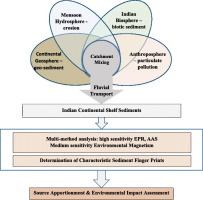当前位置:
X-MOL 学术
›
Sci. Total Environ.
›
论文详情
Our official English website, www.x-mol.net, welcomes your feedback! (Note: you will need to create a separate account there.)
Metal pollutants in Indian continental coastal marine sediment along a 3700 km transect: An electron paramagnetic resonance spectroscopic study
Science of the Total Environment ( IF 9.8 ) Pub Date : 2017-09-01 , DOI: 10.1016/j.scitotenv.2017.08.065 R. Alagarsamy , S.R. Hoon
Science of the Total Environment ( IF 9.8 ) Pub Date : 2017-09-01 , DOI: 10.1016/j.scitotenv.2017.08.065 R. Alagarsamy , S.R. Hoon

|
We report the analysis and geographical distribution of anthropogenically impacted marine surficial sediments along a 3700 km transect around the continental shelf of India. Sediments have been studied using a mixed analytical approach; high sensitivity electron paramagnetic resonance (EPR), chemical analysis and environmental magnetism. Indian coastal marine deposits are heavily influenced by monsoon rains flushing sediment of geological and anthropogenic origin out of the subcontinental river systems. That is, climatic, hydro-, geo- and anthropogenic spheres couple strongly to determine the nature of Indian coastal sediments. Enrichment of Ni, Cu and Cr is observed in shelf sediments along both east and west coasts associated with industrialised activities in major urban areas. In the Gulf of Cambay and the Krishna and Visakhapatnam deltaic regions, levels of Ni and Cr pollutants (≥ 80 and ≥ 120 ppm respectively) are observed, sufficient to cause at least medium adverse biological effects in the marine ecosystem. In these areas sediment EPR spectra differ in characteristic from those of less impacted ones. Modelling enables deconvolution of EPR spectra. In conjunction with environmental magnetism techniques, EPR has been used to characterise species composition in coastal depositional environments. Paramagnetic species can be identified and their relative concentrations determined. EPR g-values provide information about the chemical and magnetic environment of metals. We observe g-values of up to 5.5 and large g-shifts indicative of the presences of a number of para and ferrimagnetic impurities in the sediments. EPR has enabled the characterisation of species composition in coastal depositional environments, yielding marine sediment environmental ‘fingerprints’. The approach demonstrates the potential of EPR spectroscopy in the mapping and evaluation of the concentration and chemical speciation in paramagnetic metals in sediments from marine shelf environments and their potential for source apportionment and environmental impact assessment.
中文翻译:

3700 km横断面印度大陆沿海海洋沉积物中的金属污染物:电子顺磁共振光谱研究
我们报告了3700人为影响的海洋表层沉积物的分析和地理分布 km横贯印度大陆架。已经使用混合分析方法研究了沉积物。高灵敏度电子顺磁共振(EPR),化学分析和环境磁性。印度沿海海洋沉积物受到季风雨的严重影响,这些雨水冲刷了次大陆河流系统中地质和人为来源的沉积物。也就是说,气候,水文,地理和人为因素之间的强烈联系决定了印度沿海沉积物的性质。在东部和西部沿海的架子沉积物中观察到了镍,铜和铬的富集,这与主要城市地区的工业化活动有关。镍和铬的污染物在坎贝的湾和克里希纳和维萨卡帕特三角洲地区,水平(≥ 80和≥ 120 分别观察到ppm),足以在海洋生态系统中至少引起中等程度的不利生物学影响。在这些地区,沉积物EPR谱的特征与受影响较小的那些不同。通过建模,可以对EPR光谱进行反卷积。结合环境磁技术,EPR已用于表征沿海沉积环境中的物种组成。可以识别顺磁性物质并确定其相对浓度。EPR g值提供有关金属化学和磁性环境的信息。我们观察到高达5.5的g值和较大的g位移,表明沉积物中存在许多顺磁性和亚铁磁性杂质。EPR可以表征沿海沉积环境中的物种组成,产生海洋沉积物环境“指纹”。该方法证明了EPR光谱技术在海洋架环境沉积物中顺磁性金属的浓度和化学形态的制图和评估中的潜力,以及其在源分配和环境影响评估中的潜力。
更新日期:2017-09-13
中文翻译:

3700 km横断面印度大陆沿海海洋沉积物中的金属污染物:电子顺磁共振光谱研究
我们报告了3700人为影响的海洋表层沉积物的分析和地理分布 km横贯印度大陆架。已经使用混合分析方法研究了沉积物。高灵敏度电子顺磁共振(EPR),化学分析和环境磁性。印度沿海海洋沉积物受到季风雨的严重影响,这些雨水冲刷了次大陆河流系统中地质和人为来源的沉积物。也就是说,气候,水文,地理和人为因素之间的强烈联系决定了印度沿海沉积物的性质。在东部和西部沿海的架子沉积物中观察到了镍,铜和铬的富集,这与主要城市地区的工业化活动有关。镍和铬的污染物在坎贝的湾和克里希纳和维萨卡帕特三角洲地区,水平(≥ 80和≥ 120 分别观察到ppm),足以在海洋生态系统中至少引起中等程度的不利生物学影响。在这些地区,沉积物EPR谱的特征与受影响较小的那些不同。通过建模,可以对EPR光谱进行反卷积。结合环境磁技术,EPR已用于表征沿海沉积环境中的物种组成。可以识别顺磁性物质并确定其相对浓度。EPR g值提供有关金属化学和磁性环境的信息。我们观察到高达5.5的g值和较大的g位移,表明沉积物中存在许多顺磁性和亚铁磁性杂质。EPR可以表征沿海沉积环境中的物种组成,产生海洋沉积物环境“指纹”。该方法证明了EPR光谱技术在海洋架环境沉积物中顺磁性金属的浓度和化学形态的制图和评估中的潜力,以及其在源分配和环境影响评估中的潜力。


























 京公网安备 11010802027423号
京公网安备 11010802027423号